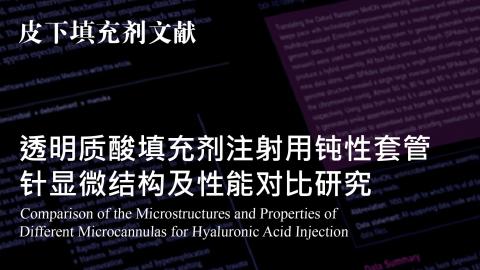
- 2553人
- 分享收藏
【皮下填充物文献】透明质酸填充剂注射用钝性套管针显微结构及性能对比研究
Comparison of Different Microcannulas
简介
【 文献重点摘要 】
Background: Microcannulas are used for hyaluronic acid and other filler injections and reduce the side effects and complications. There are several microcannulas and the differences between microcannulas have not been carefully investigated. The purpose of this study was to compare the microstructures and properties of different microcannulas by several trials and provide guidance for clinical application.
Methods: Nine types of microcannulas from different manufacturers were chosen. Scanning electron microscopy was used to obtain high-definition images of microstructures, chemical composition analyzers were used to test the chemical composition of the tips, and a universal testing machine was used to measure mechanical properties. The injection speed test recorded the time spent for the weight to push hyaluronic acid out of microcannulas. The vessel piercing force test was conducted to simulate the process of puncturing the vessels in vitro.
Results: The scanning electron microscopic images showed the tip shapes and inner surfaces that may relate to the characteristics. The chemical composition of most microcannulas met the American Society for Testing and Materials standards basically. The mechanical properties were obviously different. The results of the injection speed test were discrepant more than seven times. The vessel piercing test showed which microcannula was the most difficult and easiest to puncture the aorta.
Conclusions: The results indicated that there are significant differences between different microcannulas. The differences are instructive to physicians for selecting suitable microcannulas to improve the injection effect and reduce discomfort and complications.
背景:微导管用于透明质酸和其他填充物注射,减少副作用和并发症。有几个微导管,并且微导管之间的区别没有被仔细研究。本研究的目的是通过多次试验,比较不同微导管的显微结构和性能,为临床应用提供指导。
方法:选用9种不同厂家生产的微导管。使用扫描电子显微镜获得高清晰度的显微组织图像,使用化学成分分析仪测试针尖的化学成分,使用万能试验机测试力学性能。注射速度测试记录了体重将透明质酸推出微导管所花费的时间。进行血管穿刺力试验,模拟体外血管穿透过程。
结果:扫描电镜图像显示了可能与其特征有关的针尖形状和内表面。大多数微套管的化学成分基本符合美国测试和材料协会的标准。力学性能明显不同。注射速度试验结果相差7倍以上。血管穿透试验表明,哪一种微导管最难和最容易刺穿主动脉。
结论:不同类型的微导管有明显差异。这些差异对医生选择合适的微导管,提高注射效果,减少不适和并发症有一定的指导意义。



